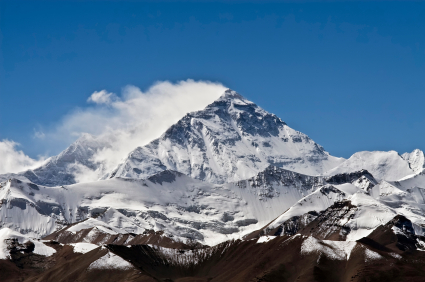Hi! My name is Ima Frawde and I am so glad that you have chosen me to be your guide during your climb of Everest.
The fact that you have chosen me indicates that you are well on your way to mastering the most important skill in climbing the mountain: Trust Everest.
And why shouldn’t you trust Everest? The mountain is totally natural; climbing is totally natural; reduced oxygen concentration at higher altitude is totally natural; and blizzards are totally natural. There’s never a need to fear anything natural.
Other people might choose professional guides to lead them, risking the chance that their climb will be marred by unnatural interventions, but by choosing me, you have demonstrated your faith in lay Everest guides. Lay Everest guides are the only ones specifically trained in low risk mountain climbing. Wait, what? Everest is not a low risk mountain? Don’t be silly. A high mountain like Everest is just a variation of normal.
Professional guides like the Sherpas have been socialized to believe that mountain climbing must involve all sorts of unnatural interventions like parkas filled with synthetic insulation, supplemental oxygen and GPS devices to map your route to the summit. Lay Everest guides understand that a truly empowering climb involves wearing only all natural vests knitted from free trade hemp, breathing only natural air and trusting that you will find your way to the top without a map.
How do I know this? From my training as a lay Everest guide. Before I received by credential (the CPG, certified professional guide) I had to watch 20 groups of people climb a mountain and then I had to climb 20 mountains. Since all mountains are the same, and Everest is just a variation of normal, I climbed a bunch of hills near my house and as we all know, hills are just short mountains.
Plus, since receiving my CPG I’ve led a million, trillion mountain expeditions from my hut at The Farm without a single death. Remarkable, I know! What? Of course I’ll be publishing that data in a peer reviewed mountain guide, just as soon as I find the time.
One of the best things about the Everest climbs that I lead is that they save so much money. We don’t need any of those fancy climbing shoes with crampons attached, no ice picks, and no rope. Sure the Sherpas insist that you need those things, but that’s because they make money by selling them to you.
How long will the climb take? I don’t set arbitrary time limits like those Sherpas who rush through climbs to get to their golf games. I’ve sent expeditions up the mountain (complete with my book Spiritual Mountain-climbing) that still haven’t come back after 5 years. I’m not worried about them because I trust Everest.
You need to prepare yourselves to withstand pressure brought by ignorant but well meaning relatives and friends who will beg you to hire those Sherpas and buy all that unnecessary gear. They may taunt you that you will change your mind about supplemental oxygen once you get to higher altitutes. That’s precisely why we don’t bring any supplemental oxygen so you won’t be tempted to use it and miss the empowering effects of hypoxia.
Don’t worry, though. Your mountain climbing doula will provide tons of support, encouraging you to get beyond the oxygen deprivation to your inner goddess.
I know that you’ve all heard stories of people who have died while climbing Everest. First of all, most of the people who have died DID have the Sherpas and the fancy gear; hardly anyone climbing Everest in hemp vests, without crampons, ice picks or ropes have died. Second, (let’s be honest here) most of the people who died on Everest weren’t meant to survive the climb. Some climbers just die and there is nothing anyone can do about it.
Are you ready? Great, let’s go. And keep in mind that if you survive this climb, next time you can climb Mount Everest unassisted!


